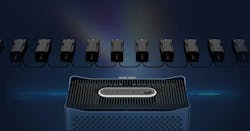Making Automation More Accessible and Efficient with an AI-Enabled Control Platform
When it comes to mechanical design and automation practices, machine control technology has come a long way in a short time. One example is Vention’s MachineMotion AI. Coupled with the company’s MachineBuilder platform, this AI-enabled system sets out to increase productivity and provide cost efficiencies in manufacturing processes, according to Vention CEO Etienne Lacroix.
Machine Design spoke with Lacroix and Sarah Webster, the company’s CMO, immediately after the new platform was commercially released in early May. The two executives explained how MachineMotion AI fits into the company’s broader mission to make automation more accessible and efficient.
At the heart of their mission is MachineBuilder 101, Vention’s cloud-based design platform and training program. The software allows users to design, simulate and price custom machines using an intuitive interface, including digital twin functionality. MachineBuilder 101 also offers a certification path for users to validate their skills—a feature that Webster says is in high demand for Vention’s growing user base.
An Overview of MachineBuilder 101
As an entry-level platform, MachineBuilder facilitates machine design from the ground up, allowing users who range from novices to seasoned engineers to create everything from basic workstations to intricate automated systems like conveyors and robotic arms. The user-friendly platform, alongside the ability to program a digital twin, allows engineers to optimize their designs before making financial investments. This foresight is invaluable, Webster says, turning complex engineering designs into manageable tasks and reducing the trial-and-error phase traditionally associated with machine design.
MachineBuilder 101 also includes a certification program that validates user's skill sets, ensuring they can confidently utilize the platform's capabilities. Ongoing educational courses will continue to evolve, supporting users as they adapt to new technological features, Lacroix explained.
Differentiating MachineMotion AI from Traditional PLCs
Lacroix says MachineMotion AI departs from traditional PLC systems, which typically require multiple interconnected components housed within custom automation enclosures. “It’s a very different approach to machine design and to machine control using that all-inclusive plug-and-play motion controller,” he said.
Some key features of MachineMotion AI include:
- A cabinet-free architecture, which Lacroix says helps to streamline design and integration.
- Plug-and-play connectivity using simple connectors, which eliminates the need for terminal blocks and pigtail wiring.
- An integrated power supply can deliver up to 3,000 W of power and support a multitude of devices, including up to 30 servo drives, Lacroix says.
- The incorporation of NVIDIA Jetson technology gives the controller the computational power necessary to run AI workloads.
- The controller has built in safety systems for compliance with regulations and the reduction of complexities.
According to Lacroix, AI capabilities can improve mechanical design and robotic systems and environments where multiple sensors and complicated mechanical fixtures are typically required. “In this world, what you need is GPU and compute power, and a bit less so of PLC,” he said. “It's not that PLCs are going away. They’re going to be a very key important devices of the robot cells or the automated equipment.” Because fewer components are needed, the shift from numerous sensors to potentially one or two high-resolution cameras allows for functions like object detection and orientation without prescriptive programming, he said.
“The fact that you no longer need a fixture, the fact that you no longer need hundreds of sensors but instead a camera, the fact that you no longer need a custom automation cabinet, but perhaps, a GPU-based control device will bring costs down and it will bring affordability up,” he said.
“You know, we make mechanical design…through our modular products…more simple overall,” Webster added. “And so people can do more of what they want to do with architecture and less of what they’re forced to do because of the limitations of assembling a lot of different products.”
Navigating Wire Complexity and Integration Challenges
Lacroix explains the daisy-chaining ability that allows for powering multiple motors in sequence without returning to a central power source, which he says simplifies cabling operations. This daisy-chaining not only minimizes the amount of wiring required but also reduces the time spent on installation and troubleshooting instead of navigating a labyrinth of wires and connectors, engineers can focus on design and innovation.
They also spend less time managing wiring tasks and more time focusing on product development. The streamlined wiring setup is designed to promote cleaner machine designs. And greater flexibility and layout. It also translates into lower material costs and less risk of wiring errors.
Moving toward a software-defined approach, Lacroix says MachineMotion AI allows engineers to make quick configuration adjustments, such as changing a sensor’s role via software, without the labor of changing physical wiring. This adaptability extends to system maintenance as well, where shall troubleshooting can be resolved remotely.
Technicians can connect to the system remotely to diagnose issues or implement changes, which minimizes downtime. Any necessary software updates can be pushed directly to the machines, ensuring that they are always operating with the latest capabilities without requiring physical access.
This ability to adapt configurations at the software level not only speeds up the response to operational needs but also allows manufacturers to implement continuous improvement practices by allowing for rapid adjustments in response to real-time data and insights.
Use Case: Advancements in Robotic Cell Design
Traditionally, robotic cells have relied heavily on complex sensor arrays, commonly consisting of 50 to 70 sensors, to facilitate functions such as motion tracking, object detection and environmental monitoring. With MachineMotion AI, engineers can use a much smaller number of high-resolution cameras powered by AI algorithms, according to Lacroix, who demonstrated an example of how MachineMotion AI works.
The interface has a library of 3,000 modular components resembling industrial “Lego” bricks. Engineers drag and drop the parts into their designs without needing to construct geometries from scratch, using a feature Lacroix calls the AI-driven Magic Ball feature. They can design robotic movements and tasks through simple graphical interactions rather than deep programming expertise.
“You simply mouse over a given mechanical use case, and we'll recommend the part that is best positioned to go to a certain place,” he explained. “By the time you’re done designing, you have a price, you have a bill of materials and you can decide to order that equipment or to simply move to the next (programming) step.” He added that the platform also eliminates the barriers imposed by traditional programming languages, democratizing access to advanced robotic technologies.
By facilitating rapid prototyping, this flexibility allows teams to iterate designs quickly and efficiently. The digital twin created during the design phase directly parallels the physical twin, ensuring that the simulation accurately reflects real-world operations. The accurate modeling allows engineers to deploy changes rapidly and adjust on-the-fly without the need for disruptive rewiring or downtime.
The system’s connection through Wi-Fi or cellular networks provide advantages during the deployment and operation stages, including pushing the latest digital twin configuration back to its physical counterpart. This integration means that adjustments made in the design software can be instantly implemented in the actual hardware, promoting a responsive and adaptable manufacturing environment, Lacroix explains, adding that workflow is not only intuitive but also streamlined. Operators can use a pendant to control the machine on the factory floor directly.
Remote Troubleshooting and Maintenance
The use of a software-defined architecture also alters maintenance and troubleshooting practices compared to traditional setups, Lacroix says. In conventional systems, identifying wiring issues or component failures typically requires on-site inspection, which can result in downtime. Technicians might have to manually examine complex wiring and connections, which can lead to lost production time.
Lacroix points out the remote troubleshooting, where engineers and support personnel can access the system digitally to diagnose issues from a distance. For example, if a motor fails, the diagnostic tools built into the platform can provide a detailed status report and show the potential failures and necessary corrective actions. This allows maintenance to be proactive for operational continuity.
Additionally, the capability to implement updates quickly helps ensure that machines operate effectively without extensive interruptions. This approach allows for ongoing augmentations to be made in real-time.
Webster adds that with training courses like MachineBuilder 101, the transition to this platform is allows engineers, whether seasoned or newcomers, to gain necessary skills for effective implementation.
About the Author
Sharon Spielman
Technical Editor, Machine Design
As Machine Design’s technical editor, Sharon Spielman produces content for the brand’s focus audience—design and multidisciplinary engineers. Her beat includes 3D printing/CAD; mechanical and motion systems, with an emphasis on pneumatics and linear motion; automation; robotics; and CNC machining.
Spielman has more than three decades of experience as a writer and editor for a range of B2B brands, including those that cover machine design; electrical design and manufacturing; interconnection technology; food and beverage manufacturing; process heating and cooling; finishing; and package converting.
Email: [email protected]
LinkedIn: @sharonspielman
Facebook: Machine Design
YouTube: @MachineDesign-EBM

Marie Darty
Group Multimedia Director, Engineering & Manufacturing
Marie Darty is a digital media professional currently serving as the group multimedia director for the Manufacturing & Engineering Group at Endeavor Business Media. A graduate of Jacksonville State University, she earned her Bachelor of Arts in digital communication with a concentration in digital journalism in December 2016. In her current role, she leads the strategy and production of multimedia content, overseeing video series planning and editing. Additionally, she oversees podcast production and marketing of multimedia content.

